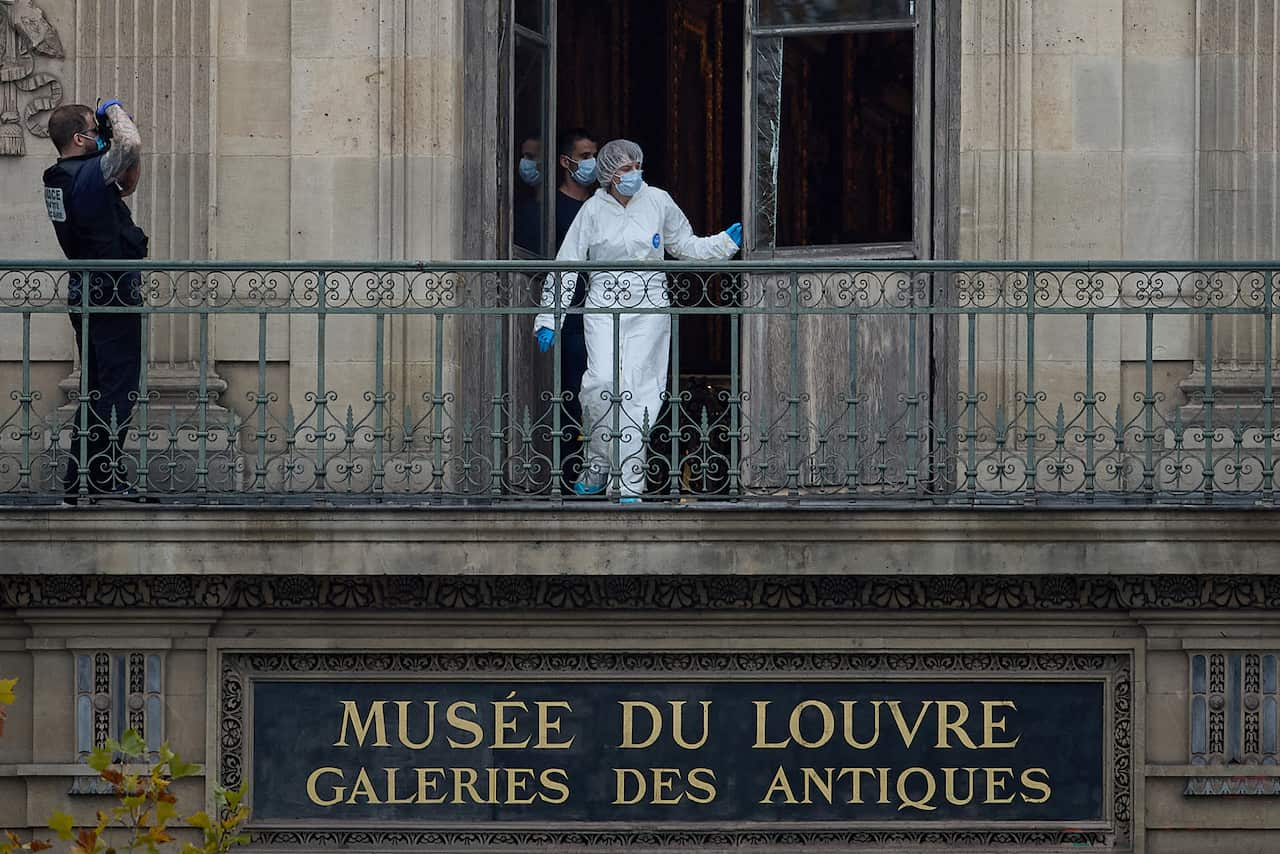Thieves made off with priceless French crown jewels after a daylight robbery of the Louvre museum in Paris.
French officials say the heist was likely committed by professionals, noting it took fewer than four minutes and without the use of violence.
Here's what we know so far.
How did the heist unfold?
Wearing balaclavas, the four thieves struck about 9.30am on Sunday (6.30pm AEDT) when the museum had already opened its doors to the public.
Using a vehicle-mounted mechanical lift with an extendable ladder, the thieves gained access to the Galerie d'Apollon building via a balcony, authorities said.
Electrical tools were used to cut through windows, with angle grinders used to threaten security guards.
Footage of the theft showed the masked robbers entering "calmly" and smashing display cases containing the jewels, culture minister Rachida Dati told French television.
"They don't target people; they enter calmly in four minutes, smash display cases, take their loot, and leave. No violence, very professional," she said.
In footage released by French media outlet BFMTV, one suspect could be seen using an electric saw to cut through a display case.
Dati said the gang tried to set fire to their vehicle outside but were stopped by a museum staff member.
The thieves escaped on motorbikes.
The Louvre, the world's most-visited museum and home to artworks such as the Mona Lisa, said on X it would remain closed for the day for "exceptional reasons".
What was stolen?
Eight pieces worth the tens of millions of dollars were stolen.
They include:
Tiara from the jewellery set of Queen Marie-Amélie and Queen Hortense.
Necklace from the sapphire jewellery set of Queen Marie-Amélie and Queen Hortense.
Earring, part of a pair from the sapphire jewellery set of Queen Marie-Amélie and Queen Hortense.
Emerald necklace from the Marie-Louise set.
Pair of emerald earrings from the Marie-Louise set.
Brooch known as the reliquary brooch.
Tiara of Empress Eugénie.
Large bodice knot (brooch) of Empress Eugénie.

A necklace and earrings from the Marie-Louise set were among the stolen pieces. Source: Supplied / Louvre Museum
Paris prosecutor Laure Beccuau said it was a mystery why the thieves did not steal the Regent diamond, which is housed in the Galerie d'Apollon and is estimated to be worth more than US $60 million ($92 million) by Sotheby's.
"I don't have an explanation," she said.
"It'll only be when they're in custody and face investigators that we'll know what type of order they had and why they didn't target that window."
How have officials reacted?
French President Emmanuel Macron promised those responsible would be caught.
"The theft committed at the Louvre is an attack on a heritage that we cherish because it is our History," he said on X.
"We will recover the works, and the perpetrators will be brought to justice."

The museum was closed while French police investigated the incident. Source: Getty / Kiran Ridley
Investigators were keeping all leads open, Beccuau said.
But she said it was likely the robbery was either commissioned by a collector, in which case there was a chance of recovering the pieces in a good state, or undertaken by thieves interested only in the valuable jewels and precious metals.
She said foreign interference was not among the main hypotheses.
Have similar thefts happened before?
The Mona Lisa was stolen from the museum in 1911 in one of the most daring art thefts in history, in a heist involving a former employee. He was eventually caught and the painting was returned to the museum two years later.
Earlier this year, officials at the Louvre requested urgent help from the French government to restore and renovate the museum's ageing exhibition halls and better protect its countless works of art.

The thieves used a freight elevator to access the room. Source: NurPhoto, Getty / Jerome Gilles
Macron said a new government plan for the Louvre announced in January "provides for strengthened security".
Dati said the issue of museum security was not new.
"For 40 years, there was little focus on securing these major museums, and two years ago, the president of the Louvre requested a security audit from the police prefect. Why? Because museums must adapt to new forms of crime.
"Today, it's organised crime — professionals."
Share

